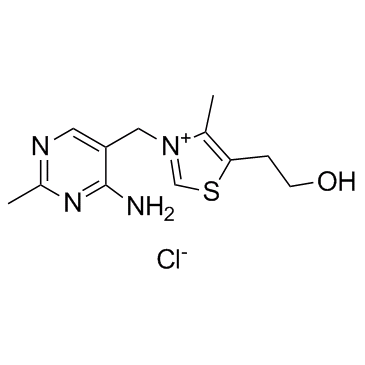Thiamine monochloride (Vitamin B1) |
| Catalog No.GC30226 |
Thiamine monochloride (Vitamin B1) (Vitamin B1) is an essential vitamin that plays an important role in cellular production of energy from ingested food and enhances normal neuronal actives.
Products are for research use only. Not for human use. We do not sell to patients.

Cas No.: 59-43-8
Sample solution is provided at 25 µL, 10mM.
Thiamine monochloride (Vitamin B1) is an essential vitamin that plays an important role in cellular production of energy from ingested food and enhances normal neuronal actives.
Thiamine levels in the blood of homozygous KO and KI mice feed a conventional diet are decreased to 0.058±0.051 and 0.126±0.092 μM, respectively, at 7 weeks compared to WT mice (0.796±0.259 μM). When WT and homozygous KO and KI mice are fed a thiamine-restricted diet (thiamine: 0.60 mg/100 g food), blood thiamine concentration at 5 and 14 days is markedly decreased to 0.010±0.009 and 0.010±0.006 μM, respectively, compared to WT mice (0.609±0.288 μM). Thiamine concentration in brain homogenate of WT mice fed a conventional diet is 3.81±2.18 nmol/g wet weight, and that of KO and KI is 1.33±0.96 and 2.16±1.55 nmol/g wet weight, respectively. Notably, thiamine concentration in brain homogenate decreased steadily in KO and KI mice fed a thiamine-restricted diet (thiamine: 0.60 mg/100 g food) for 5 days (0.95±0.72 nmol/g wet weight) and 14 days (1.11±0.24 nmol/g wet weight), respectively, compared to WT (3.65±1.02 nmol/g wet weight), before the mice presented an phenotype of disease[2].
WT, homozygous, and heterozygous KO and KI mice feed a conventional diet (thiamine: 1.71 mg/100 g) survive for over 6 months without any phenotype of disease. Homozygous KO and KI mice feed a thiamine-restricted diet (thiamine: 0.60 mg/100 g food) showe paralysis, weight loss, and immobility, and die within 12 and 30 days, respectively. Similarly, homozygous KO and KI mice feed a thiamine-restricted diet with an even lower percentage of thiamine (thiamine: 0.27 mg/100 g food) die within 14 and 18 days, respectively. However, WT and heterozygous KO and KI mice feed a thiamine-restricted diet (thiamine: 0.60 mg or 0.27 mg/100g food) survive for over 6 months without any phenotype of disease[2].
[1]. Kenneth Osiezagha, et al.Thiamine Deficiency and Delirium. Innov Clin Neurosci. 2013 Apr; 10(4): 26-32. [2]. Kaoru Suzuki, et al. High-dose thiamine prevents brain lesions and prolongs survival ofSlc19a3-deficient mice. PLoS One. 2017; 12(6): e0180279.
Average Rating: 5 (Based on Reviews and 25 reference(s) in Google Scholar.)
GLPBIO products are for RESEARCH USE ONLY. Please make sure your review or question is research based.
Required fields are marked with *




















